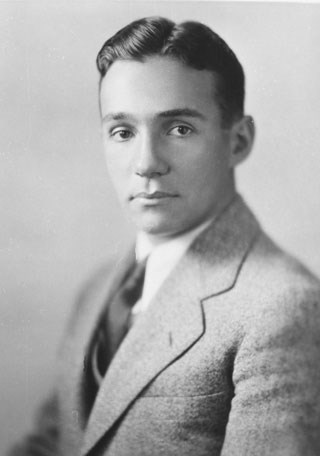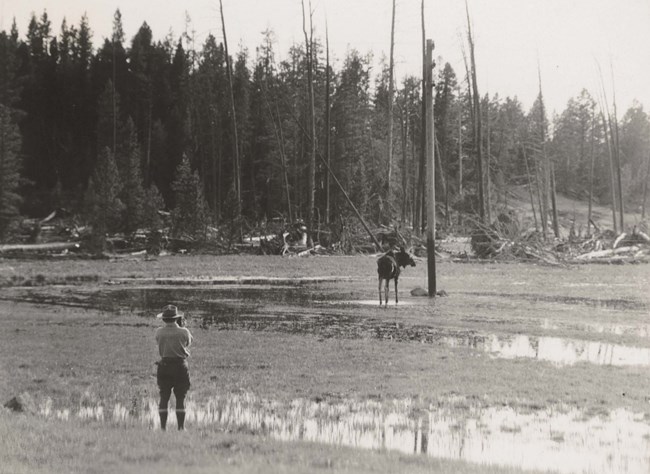
"...Sometimes while I am watching these birds on the water, the illusion of the untouchability of this wilderness becomes so strong that it is stronger Although his career lasted less than a decade, George Meléndez Wright’s many contributions to the National Park Service are as valuable today as they were a century ago. George Wright was born June 20, 1904 in San Francisco into a successful family; his father was a ship's captain and his mother's family held great political clout in her home country of El Salvador where two of Wright’s uncles had served as president. After losing both of his parents at a young age, his great aunt helped to raise him in the San Francisco area. Wright became an avid wildlife enthusiast early on, often hiking in the hills of the San Francisco Bay Area. His love of natural history led him to become a Boy Scout instructor during his teens, the President of the Audobon Club in high school, and later, to major in forestry at the University of California, Berkeley. During his college years, Wright often explored Yosemite’s backcountry as well as other parks on the west coast and helped lead students as a guide for the Sierra Club during the summer of 1922. Wright spent a lot of time in national parks, keeping detailed notes and observations about wildlife and other natural resources. In 1927, Wright became assistant park naturalist in Yosemite National Park and was the first Hispanic person to occupy a professional role in the National Park Service. His contributions to the park were many: he regularly wrote natural history articles for Yosemite Nature Notes, and was a teacher of field classes in the park. Additionally, Wright also aided the development of the Yosemite Museum. While assuming these roles, it was soon clear to Wright that wildlife management would become the focus of his National Park Service career. Wright noticed mismanagement of wildlife while living in Yosemite Valley; the abundance of deer, scarcity of mountain lions, presence of Tule elk, and the feeding of black bears for entertainment. Due to the sheer lack of staff devoted to wildlife, he took it upon himself to address the problems. In 1928, Wright set out to establish a wildlife biology plan for the National Park Service (NPS). Despite being a newcomer to the NPS, Wright managed to gain permission for his project by personally assuming all costs, including travel, equipment, and staff salaries. Using more than half of his inheritance from his father, Wright solely funded his endeavor until July of 1931, when funding for wildlife biology became a regular portion of the National Park Service’s budget. Joined by his colleagues Joseph Dixon and Ben Thompson, Wright compiled their enormous body of field research into a report, Fauna No. 1. After a second survey, Wright and Thompson compiled and published Fauna No. 2. 
Fauna No. 1 became the authoritative text on wildlife management in the parks for over 30 years. It included recommendations well ahead of its time, such as the use of bear-proof lockers to reduce human-bear conflict, a practice that would ultimately be adopted decades later. During the initial seasons of his wildlife surveys, Wright became aware of the frequent killings of predators in national parks across the nation—often witnessing park employees shoot and trap coyotes, eagles, and even badgers. Wright documented these issues and made the case for a service-wide wildlife division. In 1933, National Park Service Director Horace Albright established the Wildlife Division of the National Park Service, naming Wright the first division chief. From then until his untimely passing a few years later, Wright led the Wildlife Division at the headquarters in Washington, D.C. In 1934, President Franklin D. Roosevelt appointed him to head the National Resources Board. He spent the next two years traveling to areas and researching areas where new national parks could be established, such as Everglades National Park. Many of Wright’s ideas are easy to take for granted as fundamentals of conservation biology, but they were bold and unprecedented in the 1920s and 1930s. Although many of his policies were not fully embraced until decades after his death, he was a visionary whose ideals are still reflected in modern-day park management approaches nearly 100 years later. In 1936, while traveling from newly established Big Bend National Park in Texas to Tucson, Arizona, an oncoming vehicle collided with Wright’s vehicle, killing his passenger immediately, and Wright the following morning. At just 31, he left a lasting legacy in the National Park Service as well as the broader wildlife biologist community. After the loss of his strong leadership, the Wildlife Division struggled to obtain funding, adequate staffing, and political clout within the National Park Service for many years, with few wildlife biologists on staff and very limited research projects. The environmental movement of the 1960s saw the beginnings of a sea change within the National Park Service’s scientific endeavors, which gradually expanded in size and scope in the following decades, picking up where Wright’s legacy left off decades prior. Wright is honored with mountains named after him in both Denali National Park & Preserve as well as Big Bend National Park. |
Last updated: November 22, 2023
